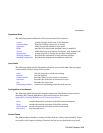Local Customization of RMS
# rcontrol configure in node=atlas2
3. Restart the partition:
# rcontrol start partition=parallel
This brings the partition back up to its full complement of nodes.
9.5 Local Customization of RMS
RMS can be customized to suit local operating patterns in a variety of ways.
Customization is done through site-specific scripts in /usr/local/rms/etc. The
following site-specific customizations are supported:
• Core file analysis
• Partition startup
• Event handling
• Switch manager configuration
If site-specific scripts exist then they override the defaults supplied with RMS.
9.5.1 Partition Startup
The default partition startup script enables or disables logging in to a node according to
the partition type. Site-specific variants might check whether users are logged in to the
node and warn them of changes. They might also check on the availability of space in
local temporary file systems.
To create a site-specific partition startup script, copy the default script
/opt/rms/etc/pstartup to /usr/local/rms/etc and modify it as required.
9.5.2 Core File Handling
By default, RMS instructs the operating system to dump core files to local temporary file
space under /local/core/rms. Change the attribute local-corepath in the
attributes table to select an alternative default directory for core files. Subdirectories
are created in local_corepath/resource-id for each resource request. Change the
attribute rms-keep-core to disable the dumping of core files.
If dumping is disabled, a core file analysis script is run on at least one node before the
core files are deleted. The default script prints a backtrace showing why the program
9-10 Setting up RMS


















